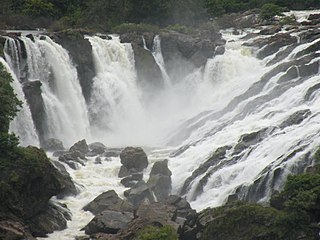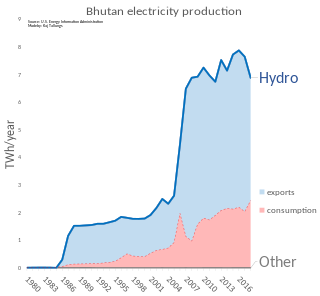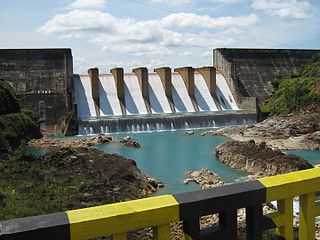
Small hydro is the development of hydroelectric power on a scale suitable for local community and industry, or to contribute to distributed generation in a regional electricity grid. Exact definitions vary, but a "small hydro" project is less than 50 megawatts (MW), and can be further subdivide by scale into "mini" (<1MW), "micro" (<100 kW), "pico" (<10 kW). In contrast many hydroelectric projects are of enormous size, such as the generating plant at the Three Gorges Dam at 22,500 megawatts or the vast multiple projects of the Tennessee Valley Authority.

Hydroelectricity, or hydroelectric power, is electricity generated from hydropower. Hydropower supplies one sixth of the world's electricity, almost 4500 TWh in 2020, which is more than all other renewable sources combined and also more than nuclear power. Hydropower can provide large amounts of low-carbon electricity on demand, making it a key element for creating secure and clean electricity supply systems. A hydroelectric power station that has a dam and reservoir is a flexible source, since the amount of electricity produced can be increased or decreased in seconds or minutes in response to varying electricity demand. Once a hydroelectric complex is constructed, it produces no direct waste, and almost always emits considerably less greenhouse gas than fossil fuel-powered energy plants. However, when constructed in lowland rainforest areas, where part of the forest is inundated, substantial amounts of greenhouse gases may be emitted.

The Mangla Dam is a multipurpose dam situated on the Jhelum River in the Mirpur District of Azad Kashmir. It is the sixth-largest dam in the world. The village of Mangla, which sits at the mouth of the dam, serves as its namesake. In November 1961, the project's selected contractors were revealed; it was announced that Binnie & Partners, a British engineering firm, was going to serve as the lead designers, engineers, and inspectors for the construction of the dam. The project was undertaken by a consortium known as the Mangla Dam Contractors, which consisted of eight American construction firms sponsored by the Guy F. Atkinson Company based in South San Francisco, California.

Karnataka Power Corporation Limited is a company owned by the government of Karnataka, and is engaged in the Service of generating electrical power in the state of Karnataka in India. The modes for generation of electric power are hydroelectric, thermal, diesel, gas, wind and solar. The company was started on 20.07.1970 due to a vision of the Karnataka government for separate entities for generation and distribution of electric power. This was done, long before world bank dictated power sector reforms were initiated in early 21st century in India. Karnataka Power Corporation Limited began its journey with a humble beginning in 1970. With an installed capacity of 746 MW (1970), it has expanded its capacity to 8738.305 MW (2019). A revenue of Rs.77442 Million in 2019 as compared, to Rs.1.30 Million in 1971, speaks volumes about KPCL's progress.

Himachal Pradesh is extremely rich in its hydroelectricity resources. The state has about twenty five percent of the national potential. About 27,436 MW of hydroelectric power can be generated in the state by the construction of various hydroelectric projects on the five perennial river basins. Out of total hydroelectric potential of the state, 10,519 MW is harnessed so far, out of which only 7.6% is under the control of Himachal Pradesh Government while the rest is exploited by the Central Government. The state government has been giving the highest priority for its development, since hydroelectric generation can meet the growing need of power for industry, agriculture and rural electrification. It is also the biggest source of income to the state as it provides electricity to other states.
Uri Dam is a 480 MW hydroelectric power station on the Jhelum River near Uri in Baramula district of the Jammu and Kashmir, India. It is located very near to the Line of Control, the de facto border between India and Pakistan. The station is largely built under a hill with a 10 km tunnel. It is of the run-of-the-river type without a large dam, since the Indus Waters Treaty gives Pakistan the exclusive right to regulate the Jhelum River. On 4 July 2014 a 240 MW Uri-II power project which is a new project located just downstream of Uri I, was inaugurated.

India is 5th globally for installed hydroelectric power capacity. As of 31 March 2020, India's installed utility-scale hydroelectric capacity was 46,000 MW, or 12.3% of its total utility power generation capacity. Additional smaller hydroelectric power units with a total capacity of 4,683 MW have been installed. India's hydroelectric power potential is estimated at 148,700 MW at 60% load factor. In the fiscal year 2019–20, the total hydroelectric power generated in India was 156 TWh with an average capacity factor of 38.71%.

The Koldam Hydropower Station commonly known as Koldam, is an embankment dam on the Sutlej River upstream of the Dehar Power House. It is 18 km from Bilaspur off the Chandigarh-Manali Highway (NH-21) near Barmana, Himachal Pradesh, India. The main purpose of the dam is hydroelectric power generation and it will support an 800 MW power station. The dam was constructed by NTPC Limited.

Energy in Bhutan has been a primary focus of development in the kingdom under its Five-Year Plans. In cooperation with India, Bhutan has undertaken several hydroelectric projects whose output is traded between the countries. Though Bhutan's many hydroelectric plants provide energy far in excess of its needs in the summer, dry winters and increased fuel demand makes the kingdom a marginal net importer of energy from India.
The Kishanganga Hydroelectric Project is a run-of-the-river hydroelectric scheme in Jammu and Kashmir, India. Its dam diverts water from the Kishanganga River to a power plant in the Jhelum River basin. It is located near Dharmahama Village, 5 km (3 mi) north of Bandipore in the Kashmir valley and has an installed capacity of 330 MW.
Bairabi Dam is a proposed 80 MW dam on the Tlawng river near Bairabi Village in Kolasib district in the state of Mizoram in India.
Mizoram is one of the fastest growing economies among the states of India with a per capital income of Rs 308571. Mizoram had the second highest GSDP growth during the 11th Five Year Plan (2007–2012) in Northeast India at 11% exceeding the target of 7.8% which is also much higher than the national average of 7.9%. During the 10th Five Year Plan (2002–2007), the Gross State Domestic Product (GSDP) was expected to grow at around 5.3% but grew at 5.7%. The biggest contributors to GSDP growth are agriculture, public administration and construction work. Tertiary sector of service sector continued to have the contribution to the GSDP with its share hovering between 58% and 60% during the past half a decade.

The Karcham Wangtoo Hydroelectric Plant is a 1,091 megawatts (1,463,000 hp) run-of-the-river hydroelectric power station on the Sutlej River in Kinnaur district of Himachal Pradesh state of India.

Kopili River is an interstate river in Northeast India that flows through the states of Meghalaya and Assam and is the largest south bank tributary of the Brahmaputra in Assam.
The Ratle Hydroelectric Plant is a run-of-the-river hydroelectric power station currently under construction on the Chenab River, downstream of the village near Drabshalla in Kishtwar district of the Indian Union Territory of Jammu and Kashmir. The project includes a 133 m (436 ft) tall gravity dam and two power stations adjacent to one another. Water from the dam will be diverted through four intake tunnels about 400 m (0.25 mi) southwest to the power stations. The main power station will contain four 205 MW Francis turbines and the auxiliary power station will contain one 30 MW Francis turbine. The installed capacity of both power stations will be 850 MW. On 25 June 2013, Prime Minister Manmohan Singh laid the foundation stone for the dam. Pakistan has frequently alleged that it violates the Indus Waters Treaty.
The Duber Khwar Hydropower Plant is located near the town of Pattan in Kohistan, Khyber Pakhtunkhwa, Pakistan on the Duber Khwar River, a right bank tributary of the Indus River. It is approximately 340 km NW from Islamabad, the federal capital of Pakistan.
Lakhwar-Vyasi Dam project on Yamuna River, includes under-construction Lakhwar Dam and Power Station, Vyasi Dam, Hathiari Power Station and Katapathar Barrage, near the Lakhwar town in Kalsi block of Dehradun district of Uttarakhand in India, for the purpose of irrigation of 40,000 hectare land and total 927 MW hydroelectric power generation. "Lakhwar Dam" is a gravity dam near the Lohari village with 300MW power generation capacity. "Vyasi Dam" will be built 5 km downstream along with 120 MW "Hathiari Power Station" further 0.5 km downstream. "Katapathar Barrage", with the maximum ponding water level at 514.5m elevation, will be built further 2.75 km downstream of the Hathiari Power Station to supply the water to stakeholder states. Project will hold 580 million cubic metres water during monsoon and release into Yamuna during dry months.
The Shahpurkandi Dam project is located on the Ravi River in Pathankot district, Punjab, India, downstream from the existing Ranjit Sagar Dam. The power houses will be constructed on Hydel Channel, which is downstream from Shahpurkandi Dam. The water released by Ranjit Sagar Dam is to be utilised for generating power for this project. The project will generate electricity of up to 206MW and provide irrigation to Punjab and Jammu and Kashmir. The construction of the dam is as per the framework of the Indus Water Treaty regarding sharing of rivers between India and Pakistan.

Kopili Hydro Electric Project is a 275 megawatts (369,000 hp), hydroelectric power project on the Kopili river and its tributary, Umrong stream. It is located in Dima Hasao district of Assam state in India. The project is developed and operated by North Eastern Electric Power Corporation Limited. It is an important project since the indian State of Assam, Arunachal Pradesh, Manipur, Meghalaya, Mizoram, Nagaland and Tripura benefit from this project.
Tuirial Hydro Electric Project is NTPC NEEPCO owned project situated on Tuirial river system and is located in the Aizawl district of Mizoram adjoining Cachar district of Assam. Total installed capacity of project is 60(2 x 30) MW.












